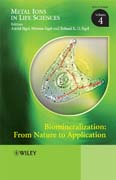
Biomineralization: from nature to application
Sigel, Astrid
Sigel, Helmut
Sigel, Roland K.O.
Biomineralization is a hot topic in the area of materials, and this volume inthe Metals Ions in Life Sciences series takes a systematic approach, dealing with all aspects from the fundamentals to applications. Key biological features of biomineralization, such as gene directed growth and the role of enzymes are covered, as are new areas, including copper/zinc in the jaws of invertebrates or magnetic biomaterials that help birds with navigation Mrs. Astrid Sigel, Prof. Helmut Sigel and, c/o Dept. of Chemistry, Inorganic Chemistry, University of Basel, Spitalstrasse 51, CH-4056 Basel, Switzerland. Professor Roland K. O. Sigel, Institute of Inorganic Chemistry, Universityof Zurich, Winterthurerstrasse 190, CH-8057 Zurich, Switzerland. INDICE: HISTORICAL DEVELOPMENT AND PERSPECTIVES OF THE SERIES. PREFACE TO VOLUME 4. CONTRIBUTORS TO VOLUME 4. TITLES OF VOLUMES 1-44 IN THE METAL IONS IN BIOLOGICAL SYSTEMS SERIES. CONTENTS OF VOLUMES IN THE METAL IONS IN LIFE SCIENCES SERIES. (1) Crystals and Life. An Introduction (Arthur Veis). Abstract. 1. Introduction. 2. Global Effects. 3. Minerals within Living Systems. 4. Concluding Remarks. Acknowledgments. Abbreviations. References. (2) What Genes andGenomes Tell Us about Calcium Carbonate Biomineralization (Fred H. Wilt and Christopher E. Killian). Abstract. 1. Introduction. 2. One Gene-One Protein Approaches. 3. Many Genes-One Structure Approaches. 4. General Conclusions. Acknowledgments. Abbreviations. References. (3) The Role of Enzymes in Biomineralization Processes (Ingrid M. Weiss and Frédéric Marin). Abstract. 1. Introduction. 2. From Ions to Minerals: A Pathway Paved by Enzymes. 3. The “Evolution” ofSolids: A Complex Network of Regulation. 4. Mimicking Nature: How Far Can theDesign of Biomineralization Enzymes Take Us? 5. Conclusions. Acknowledgments.Abbreviations. References. (4) Metal-Bacteria Interactions at Both the Planktonic Cell and Biofilm Levels (Ryan C. Hunter and Terry J. Beveridge). Abstract. 1. Introduction. 2. Planktonic Bacterial Cells. 3. Metal-Microbe Interactions. 4. Microbial Biofilm Communities. 5. Biofilm Microenvironments and Their Impact on Geochemical Interactions. 6. Concluding Remarks. Acknowledgments. Abbreviations and Definitions. References. (5) Biomineralization of Calcium Carbonate. The Interplay with Biosubstrates (Amir Berman). Abstract. 1. Introduction. 2. Control in Biological Mineralization. 3. Recent Perspectives on Mineralization Strategies. 4. CaCO3 Growth in Confinement. 5. Crystal Assembly. 6. In Vitro Studies of CaCO3 Mineralization. 7. Calcium Carbonate Nucleation and Growth on Artificial Substrates. 8. Summary and Outlook. Acknowledgments. Abbreviations. References. (6) Sulfate-Containing Biominerals (Fabienne Bosselmann andMatthias Epple). Abstract. 1. Sulfate-Containing Biominerals: An Overview. 2.Gypsum and Bassanite (Calcium Sulfates). 3. Celestite (Strontium Sulfate). 4.Barite (Barium Sulfate). 5. Jarosite (Potassium Iron Hydroxide Sulfate). 6. Concluding Remarks. Acknowledgments. References. 7 OXALATE BIOMINERALS. (7) Oxalate Biominerals (Enrique J. Baran and Paula V. Monje). Abstract. 1. Introduction. 2. Metallic Oxalates: Physico-Chemical and Structural Properties. 3. Calcium Oxalates in Plants. 4. Calcium Oxalates in Other Forms of Life. 5. Other Oxalate Biominerals. 6. Pathological Oxalates. 7. Oxalates in the Environment. 8. Oxalate Degrading Systems. 9. Conclusions and Perspectives. Acknowledgments. Abbreviations. References. 8 MOLECULAR PROC. (8) Molecular Processes of Biosilicification in Diatoms (Aubrey K. Davis and Mark Hildebrand). Abstract. 1. Introduction. 2. Silicon Transport. 3. Silica Structure Formation. 4. Regulation of Structure Formation. 5. Manipulation of Diatom Silica Structure. 6. Concluding Remarks and Future Directions. Acknowledgments. Abbreviations. References. (9) Heavy Metals in the Jaws of Invertebrates (Helga C. Lichtenegger, Henrik Birkedal, and J. Herbert Waite). Abstract. 1. Introduction. 2. Iron Biomineralization in Chitons and Limpets. 3. Copper and Zinc in Marine Worm Jaws. 4. Zinc and Manganese in Arthropods. 5. Heavy Metals and Jaw Mechanics. 6. GeneralConclusions. Acknowledgment. Abbreviations and Definitions. References. (10) Ferritin. Biomineralization of Iron(Elizabeth C. Theil, Xiaofeng S. Liu, and Manolis Matzapetakis). Abstract. 1. Introduction. 2. Protein Nanocage Structures. 3. Iron Entry: The Protein Ferroxidase Site. 4. Mineral Precursor Translocation, Nucleation, and Mineralization. 5. Ferritin Demineralization and the Nanocage Gated Pores. 6. Summary and Perspective. Acknowledgments. Abbreviations and Definitions. References. (11) Magnetism and Molecular Biology of Magnetic Iron Minerals in Bacteria (Richard B. Frankel, Sabrina Schubbe, and Dennis A. Bazylinski). Abstract. 1. Introduction. Magnetotactic Bacteria. 2. Molecular Biology of Magnetosome Chain Formation. 3. Magnetic Properties of Magnetosomes.4. Conclusions. Acknowledgments. Abbreviations. References. (12) Biominerals.Recorders of the Past? (Danielle Fortin, Sean Langley, and Susan Glasauer). Abstract. 1. Introduction. 2. What Are Biominerals? 3. Biominerals as Biosignatures? 4. Tools to Study Biosignatures. 5. General Conclusions. Acknowledgments. Abbreviations. References. (13) Dynamics of Biomineralization and Biodemineralization (Lijun Wang and George H. Nancollas). Abstract. 1. Introduction. 2. Nucleation and Crystal Growth. 3. Dissolution. 4. Conclusion and Future Directions. Acknowledgments. Abbreviations and Definitions. List of Symbols. References. (14) Mechanism of Mineralization of Collagen-Based Connective Tissues (Adele L. Boskey). Abstract. 1. Introduction. 2. Function of Collagen in the Regulation of Vertebrate Biomineralization. 3. Comparative Composition of the Organic Components of Collagenous Mineralized Tissues. 4. Is there a Uniform Theory of Vertebrate Mineralization? Acknowledgments. Abbreviations. References. (15) Mammalian Enamel Formation (Janet Moradian-Oldak and Michael L. Paine). Abstract. 1. Introduction. 2. Delineation of the Extracellular Space. 3. Ion Composition and Transport. 4. The Organic Matrix Components. 5. Function of Organic Matrix in Enamel Formation. 6. Matrix Degradation. 7. Conclusions. Acknowledgments. Abbreviations. References. (16) Mechanical Design of Biomineralized Tissues. Bone and Other Hierarchical Materials (Peter Fratzl). Abstract. 1. Introduction. 2. Growth, Self-Repair, and Structural Hierarchies. 3. Hierarchical Structure of Bone. 4. Hierarchical Structure of a Silica Sponge Skeleton. 5. Some Structural Elements with Mechanical Function. 6. Conclusions. Acknowledgments. References. (17) Bioinspired Growth of Mineralized Tissue (Darilis Suárez-González and William L. Murphy). Abstract. 1. Introduction. 2. Natural Development of Bone. 3. Connective Tissue Progenitor Cells. 4. Inductive Soluble Factors. 5. Bone Structural Properties. 6. Scaffold Materials for Bioinspired Mineralized Tissue Fabrication. 7. Summary. Acknowledgments. Abbreviations and Definitions. References. (18) Polymer-Controlled Biomimetic Mineralization of Novel Inorganic Materials (Helmut Cölfen and Markus Antonietti). Abstract. 1. Introduction. 2. Different Crystallization Modes and Ways to Modify Crystallization. 3. Polymer-Controlled Crystallization. 4. Conclusion. 5. Current Trends and Outlook to the Future. Acknowledgments. Abbreviations. References. SUBJECT INDEX.
- ISBN: 978-0-470-03525-2
- Editorial: John Wiley & Sons
- Encuadernacion: Cartoné
- Páginas: 700
- Fecha Publicación: 04/08/2008
- Nº Volúmenes: 1
- Idioma: Inglés
